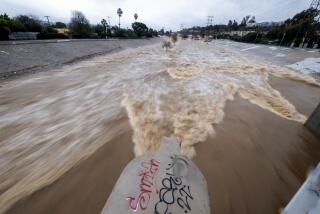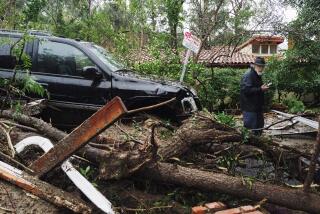Northern California braces for flooding; Don Pedro spillway opened
Reporting from Oroville, Calif. — Water came gushing down the spillway at Don Pedro Dam in Stanislaus County Monday afternoon, further proof — if any were needed — that this is a rainy season for the record books in much of California.
It was only the second time the spillway had been used, and the first time in 20 years, as officials sought to keep the Don Pedro Reservoir from overflowing.
Residents along the Tuolumne River were not forced to evacuate, but “we are strongly encouraging people to seek shelter and move to higher ground,” Stanislaus County Sheriff Adam Christianson said at a news conference. “Our No. 1 priority is the safety and security of the people here in Stanislaus County.”
The Don Pedro release came as much of the state’s northern half was being hit with a colossal drenching — one expected to drop as much as 9 inches of rain in areas from Santa Cruz County along the coast to the Feather River Basin, far inland. People living along waterways braced for flash floods and evacuations.
It came with memories still fresh of the crisis that developed just over a week ago at Oroville Dam, some 180 miles to the north. Both spillways were damaged, and fears of catastrophic flooding prompted the evacuation of more than 100,000 people.
Turlock Irrigation District officials said Monday that the structural integrity of the Don Pedro dam and spillway are “not in question,” and that the amount of water being released would be far less than in 1997, when major flooding occurred.
The Don Pedro spillway will remain open for about four days, with water flowing through at 18,000 to 30,000 cubic feet per second, officials said.
Many parts of the region — especially in the San Joaquin and Sacramento River valleys and Sierra Nevada — are on track to have the wettest winter on record. Numerous reservoirs are close to capacity, and streams and rivers are primed for flooding.
Emergency officials across many parts of the state coordinated to keep a close eye on the storm, with dozens gathered at a command post near Sacramento.
They urged residents to put together a “go bag” containing important items such as medications and hard-to-replace documents, as well as to plan for the needs of pets and other animals. They also urged people to stay informed and to know the non-emergency number to their local authorities.
“So far, it’s been a lot of getting ready and hoping everything goes well,” said Brad Alexander, spokesman for the Governor’s Office of Emergency Services. “We’re hoping we won’t need to use all our resources, but we’re ready if we need to.”
By noon Monday, the first wave of the storm had moved through, but forecasters said the heaviest rain was expected to hit on Monday evening and Tuesday.
On Sunday, the weather service warned that the San Joaquin River at Vernalis “has reached danger stage. Greater risk for levee problems.”
There were several areas at risk along the river, including Lathrop, Stevinson and Newman.
Officials also said several other waterways were at major risk of flooding, including the Yolo Bypass, Clear Lake, and the Sacramento, Cosumnes, Mokelumne, Merced and Tuolumne rivers.
Rains were also pounding coastal areas. Flash-flood warnings were issued for parts of Big Sur, parts of Sonoma County and San Benito County and communities in the hills above Santa Cruz. Flight delays were hitting San Francisco International Airport.
South of San Jose, Coyote Creek was at risk of exceeding flood levels at Edenvale.
Monday night, rising flood waters prompted Lake County authorities to order some residents of Lakeport to leave their homes, and San Joaquin County officials ordered evacuations following a levee breach along the San Joaquin River.
In Maxwell, a small rural town in Colusa County, crews on Saturday had to evacuate 100 people, some by boat, about 2 a.m. because of flooding.
“Trouble is, we’re getting a lot of rain in an area already saturated from previous storms,” said Colusa County Sheriff’s Lt. Neil Pearson, 52, a lifelong resident of the farming country northwest of Sacramento. “So, all that rain is pooling up in the northern San Joaquin Valley basin, overwhelming our creeks, gullies, sloughs, ditches and rice fields.”
Maxwell is about 50 miles from Oroville, which for the last week has been the scene of a national drama as officials worked furiously to lower the lake level and repair the damaged emergency spillway at Oroville Dam.
On Monday, crews continued fortifying eroding fissures on adjacent hillsides with rocks and cement. They used cranes on floating barges to yank tons of debris from a murky pool of water at the bottom of one of the spillways.
Officials anticipated a 5-foot increase in the elevation of water behind Oroville Dam by midnight, said Bill Croyle, acting director of the California Department of Water Resources. But he said the water would be absorbed in the reservoir, which by Monday had been drained down to 849 feet — 51 feet below capacity.
“Attacking the debris beneath the spillway is a priority for us,” he said. “But the spillway remains stable; although we see occasional additional erosion here and there.”
The trouble at Oroville Dam began earlier this month after state officials began sending water down the facility’s main concrete spillway. The flows were halted after engineers discovered that a huge, jagged crater had opened up in the long, concrete chute.
Since then, the hole has grown to 500 feet in length and 45 feet deep, allowing releases of water down the damaged spillway to carve immense gullies in adjacent earthen slopes shouldering the right side of the nation’s tallest dam.
Croyle said the agency may eventually decide to scrap the damaged main spillway and replace it with a new one.
“Everything is on the table,” he said.
State officials hope to have the main and emergency spillways fully functional again before the next flood season begins.
As of Monday, the estimated costs of the effort to shore up the dam’s damaged spillways had climbed to more than $22 million, according to a state incident report.
Back in small towns like Maxwell, officials focused on keeping the public safe. In this part of California, Pearson said, flooding spreads over a wide area, covering rural roads that crisscross farmlands that serve travelers from across the state.
“Some of those folks choose to ignore blockade signs that say, ‘Stop. Road closed. Dangerous flooding ahead,’” he said. “Next thing you know, they’re up to their armpits in water and calling for someone to help get them out.”
Times staff writer Liam Dillon in Modesto contributed to this report. Sahagun reported from Oroville, Bermudez from Los Angeles.
Twitter: @louissahagun
Twitter: @LATbermudez
ALSO
Damage to Oroville’s main spillway ‘was an accident waiting to happen’
Government severely misjudged strength of Oroville emergency spillway, sparking a crisis
‘It’s flooding! Get out! Get out!’: Residents have little warning as floodwaters inundate town
UPDATES:
9:05 p.m.: This post was updated with evacuations in San Joaquin County because of a broken levee.
8:35 p.m.: This post was updated with new reaction and details.
5 p.m.: This post was updated with a new cost estimate for the Oroville spillway incident.
4:10 p.m.: This post was updated with additional information about the spillway release.
3:10 p.m.: This post was updated with spillway in use.
2:35 p.m.: This post was updated with more on the Don Pedro Reservoir spillway flow.
1 p.m.: This post was updated with an announcement that the spillway at Don Pedro Reservoir would be opened at 3 p.m.
This post was originally published at 8:10 a.m.
More to Read
Sign up for Essential California
The most important California stories and recommendations in your inbox every morning.
You may occasionally receive promotional content from the Los Angeles Times.












